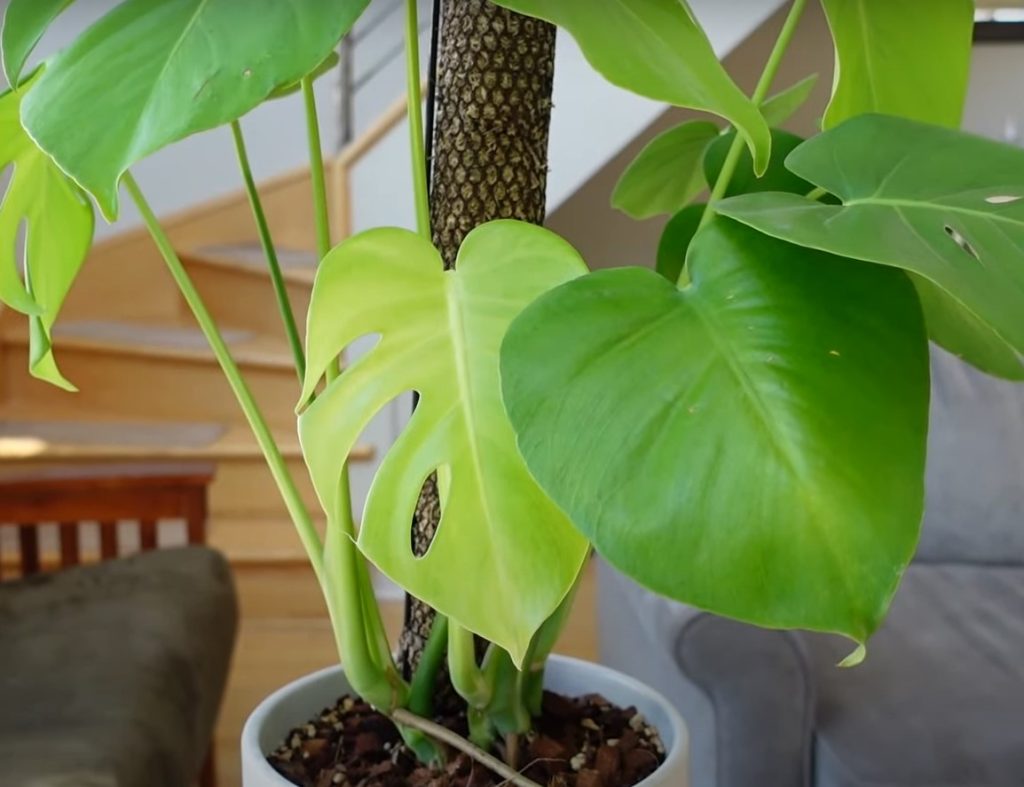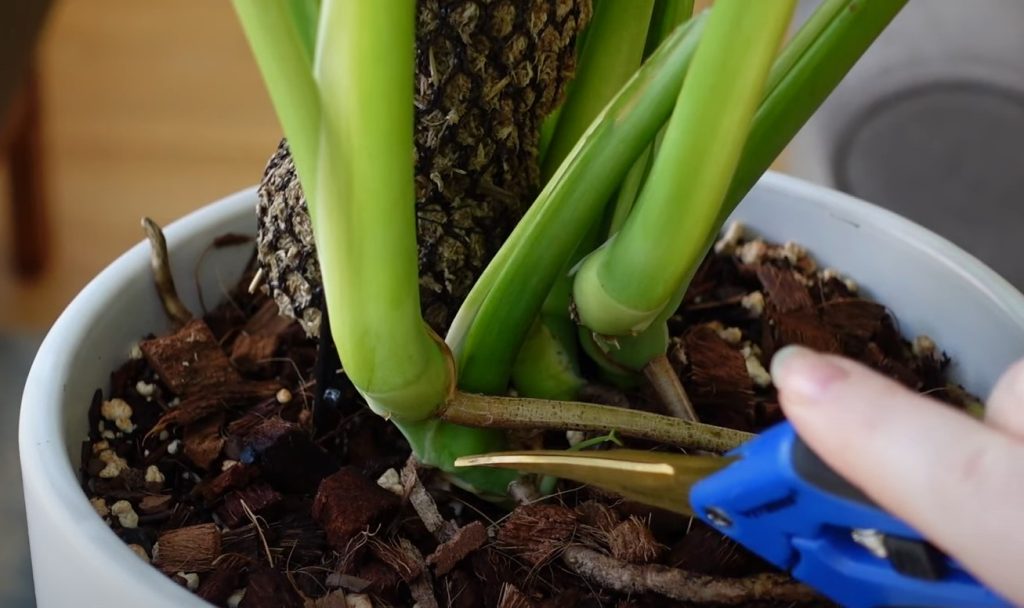The Monstera deliciosa plant, commonly known as the Split Leaf Philodendron or the more famous name, Swiss Cheese Plant, is among the best houseplants that you can find in the market. It is a prized plant due to its huge, dark green foliage that are pierced with fenestrations.
This plant easily brings an exotic and tropical vibe to any space because of its distinct, premium look.
Not just that, they are perfect for beginner plant parents because they can be low-maintenance. Meeting its basic needs and care will surely bless you with robust growth for many years.
However, because this plant is fast-growing, you may easily find yourself getting lost to its lushness.
Hence, from time to time, you must trim down your Swiss Cheese, especially during their active growing season, where they just grow wildly.
In this article, we will go through all the information that you must know about pruning your Swiss Cheese Plant.
We will also discuss the benefits of pruning and how losing some plant parts will make your plant grow more.
Without further ado, let’s delve deep into the things you’ll need to know about the process of pruning a Swiss Cheese Plant!
Getting to Know Swiss Cheese Plant
Monstera deliciosa is an Aroid member of the Monstera genus. It is a close relative to Alocasias, Philodendrons, and Syngoniums.
This plant is known to be peculiar due to the dramatic transformation of its juvenile stage to its mature one, where leaf slots and fenestrations become more prominent.
The genus name Monstera is derived from the Latin word “monstrum”, which means “abnormal” or “monstrous”. This refers to the quirky and unusual characters of the leaves having fenestrations and natural holes.
The care for this plant is simple and straightforward. As a great overview, your Swiss Cheese plant thrives best in bright, indirect light, moderate humidity, and in a rich, airy, well-draining soil.
It prefers a temperature between 70°F to 75°F, similar to its tropical natural habitat.
You might like: Why Does My Monstera Have Brown Spots? (6 Causes + Fix)
Should You Prune Your Swiss Cheese Plant?

If you have been an owner of a Swiss Cheese Plant for a long time, for sure, you have already noticed how aggressive a grower they are.
They can literally fill up a space for just a short amount of time, given the right conditions. So the question is, should you prune and trim your plant?
There really is NO definite answer.
Your Monstera plants are adaptive to extreme conditions given that they thrive in wild areas in the tropical rainforests. They are strong and hardy plants that can grow for a prolonged time without cutting or pruning.
But that doesn’t mean that pruning will damage your plant. In fact, pruning dead or damaged leaves and excessive growth were seen to be beneficial.
Ultimately, it depends on two things: your preference of whether or not you like an overgrown Monstera plant and the necessity to prune when the plant is damaged and needs it.
You don’t have to worry about pruning since your Swiss Cheese plant recovers faster than most of the plants.
Read more to learn about the process of pruning a Swiss Cheese Plant and how you can keep it at its best look.
How Do You Prune Your Swiss Cheese Plant?
Pruning your Swiss Cheese Plant is not really a technical process and no mastery level is needed.
It is a simple garden task that all plant owners will find easy to do. You can go about pruning your plant with just minimal care and a bit of planning to ensure overall success.
However, no matter how simple this task is, there are necessary things that you must always keep in mind when you plan to prune your Swiss Cheese plant in your gardens.
Here are the steps you can follow to prune your plant:
1. Prune your plant preferably in early spring
In pruning, you may not know this, but timing is very crucial.
Different seasons have different effects on the plants, greatly affecting their metabolic physiological processes which could be a make or break for your Swiss Cheese.
The best time to prune your Swiss Cheese plant is before its active growing season.
This is in early spring when your plant is actively making fresh growths. An actively growing plant means faster growth to fill your pruned plant and keep it functioning and healthy.
On the other hand, the worst time would be fall and early winter since light is insufficient to keep the plant from growing actively.
Furthermore, cold temperatures have a high tendency to inflict damage to tender, fresh shoots that start to emerge, or to open cut parts. This makes your plant susceptible to diseases and rotting.
2. Prepare necessary tools for pruning ahead
Like any other task, preparation is very important. When it comes to pruning activities, it is always better to prepare the basic supplies needed.
A sharp pruning shear, a pair of scissors, a cutter, protective gloves, and garbage bags are what you essentially need.
Before pruning your Swiss Cheese Plant, do not ever forget to clean or sanitize your cutting tools. Sanitization will prevent spreading of diseases from plant to plant, which you really do not want to happen in your garden.
Wash your tools also after using them!
If you have highly sensitive skin, plant saps and thorns or spines can cause skin irritations so it is best to wear protective gloves. Do not forget to wash your hands with mild soap afterwards.
3. Identify the nodes for easy pruning and trimming

You do not just want to cut anywhere you like and risk the plant to go bald, right?
So before you make the first cut, make sure you identify which part of the plant is actively growing.
Determining the node or active growing points on the stem to know where fresh leaves will grow from.
This is a fairly easy task but it still takes practice. To identify which nodes are active, just look for spots on your plant that have different colors and more slightly raised from the stem. These spots are where new leaves will emerge, and where you do not want to cut.
Cut above the identified active nodes. This will surely stimulate the growth on that node since more nutrients will be allocated there.
Do take note that a more mature Swiss Cheese can grow more than one leaves on a single note so don’t be surprised when you see them.
4. Make a proper cut on your Swiss Cheese Plant
Cutting may be a simple task but there are different ways you must cut depending on your desired outcome.
If you are interested in doing propagations to your Swiss Cheese plant, then you must cut your plant appropriately. Cutting for the sake of pruning or trimming only is different from stem cuttings for propagation.
If you cut plants for propagation purposes, make sure you cut at the very least 2 inches below a node. This will ensure that there is enough space for the roots to grow.
However, if you just aim to trim down your plant or remove damaged and dying parts, you should cut above the plant node instead.
Editor’s Note: Remember to choose the right node to cut to ensure you promote healthy growth to your plant, and not just control the spread and shape of it.
5. Trim aerial roots when necessary during pruning
Pruning is proven to help your Swiss Cheese plant, or any other plants, maintain a healthy and full appearance.
Pruning stems and leaves will encourage new stems and leaves to grow. However, this is true to the aerial roots as well.
Removing unhealthy aerial roots will also promote growth of new, fresh, healthier ones.
This will not just give your Monstera the full and healthy look, but it also deals with root-bound issues. Trimming down roots will give your plant more space if it is already compacted.
2 Things To Consider When Pruning Your Swiss Cheese Plant
Avoid propagating accidentally
When you are done pruning and trimming down your Swiss Cheese plant, make sure you throw the cuttings properly in the trash if you have no plans on propagating them.
If you just throw them anywhere, they can easily take root in the ground and can be invasive if left unchecked.
Consider fertilizing when you prune
Feeding your plant will give it a boost it needs to grow healthily and develop fresh parts.
This is not necessary but your plant will surely benefit if you keep the nutrients in its potting mix replenished. A good plant care routine includes plant feeding.
Why Do You Need To Prune Your Swiss Cheese Plant?
Your plants can go on and grow without pruning for many years, as they do in the wild. However, there are benefits that your plant can have when you prune them regularly.
Here are some of the reasons why you need to prune your Swiss Cheese Plant:
Pruning keeps the plant healthy.
Removing brown stems, damaged and yellowing leaves maintain the vigor of your plant. It will make it easier for your plant to grow as it can focus its nutrients on putting out fresh growths rather than sustaining these already damaged parts.
Pruning keeps your plant from getting unruly.
Since your plant is a rapid grower, trimming down helps maintain the plant’s size and shape and avoid rotting issues.
Pruning can keep your plant from pests or diseases.
Removing infected plant parts help your plant recover from serious pest infestations or diseases. Furthermore, it can avoid further spreading of these problems to other plants in your gardens.
How Often Should You Prune Your Swiss Cheese Plant?
The frequency of how often you should prune your plant depends largely on its growth and size. The smaller your plant, the less pruning should be done.
On the other hand, the larger the plant, the more frequent the trimming should be. You may prune your plant once a year, or when it is needed.
Final Thoughts
Keeping your plant looking at its best is the main goal of all plant owners. There are a lot of ways you must do to maintain the health and vigor of your plant, as it is not just a one-step process.
Pruning is one of those necessary steps.
In life, letting go of those toxic, unnecessary baggage is necessary to help you thrive and flourish. The same can be said with plants.
To have fresh and healthier plants, you must also remove dead and damaged plant parts to give way to new ones. Surely, your Swiss Cheese plant will be more stunning!
We would love to hear from your experiences on pruning your Monstera. Share them down below and let the whole world learn from you. Cheers to healthier Swiss Cheese Plants!
@Image credits: Tiia Pakk/Daria Liudnaya
